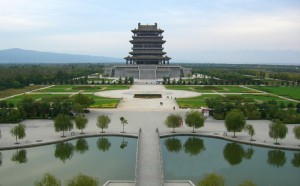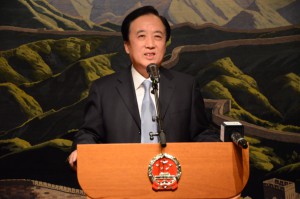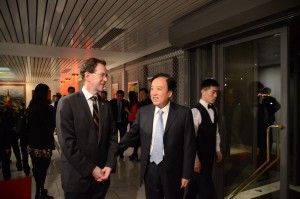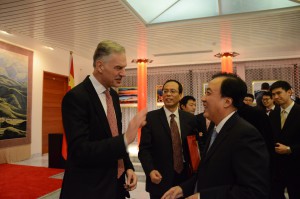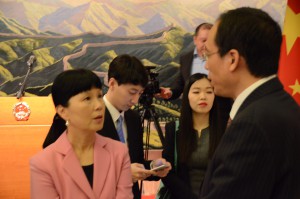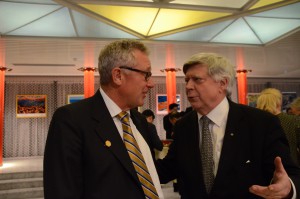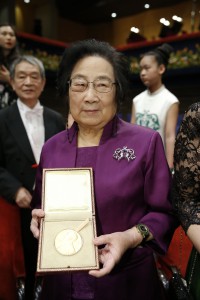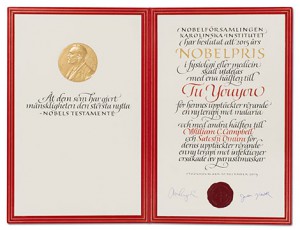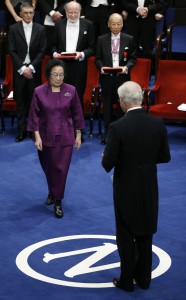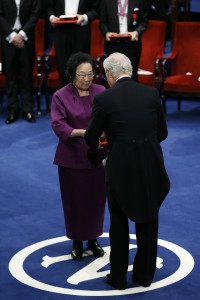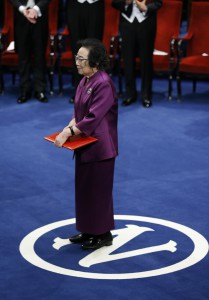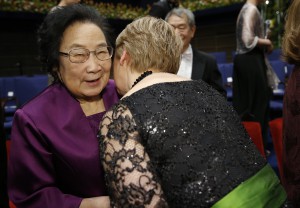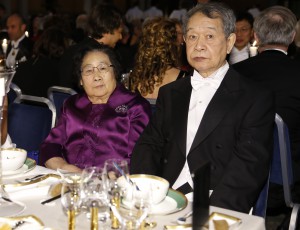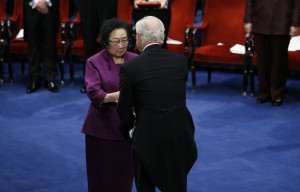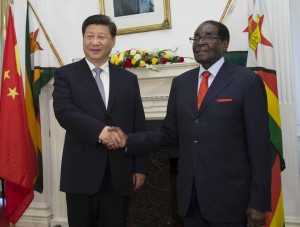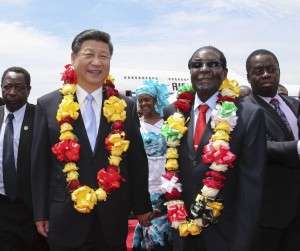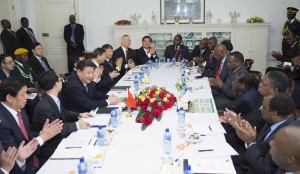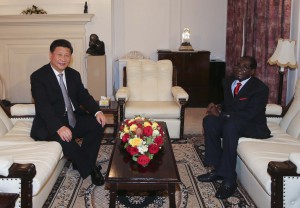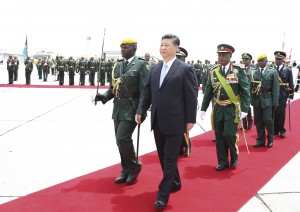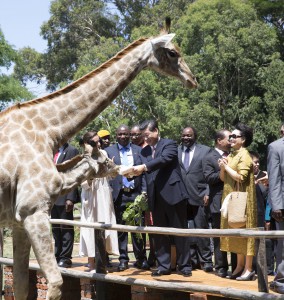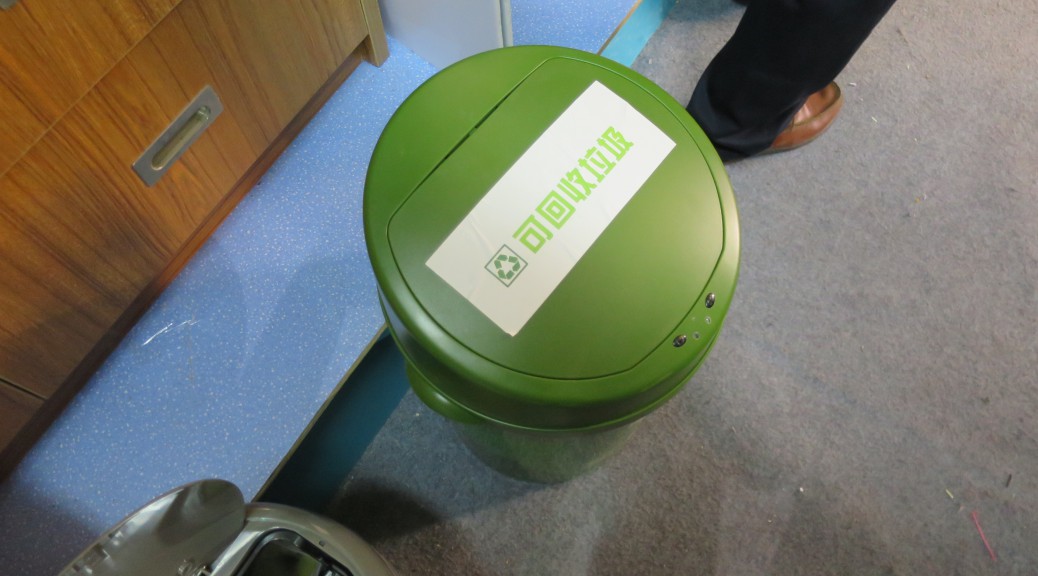Stockholm, Dec. 15(Greenpost)– Chinese Nobel Laureate in Medicine Tu Youyou gave a wonderful Nobel Lecture in the Aula at Karolinska Institute on Dec. 7, 2015 in Chinese. But with English text. The following is the whole text in English:
Tu Youyou’s Nobel Lecture.
2015-12-07
Dear respected Chairman, General Secretary, esteemed Nobel Laureates, Ladies and Gentlemen:
It’s my great honor to give this lecture today at Karolinska Institutet. The title of my presentation is Artemisinin-A Gift from Traditional Chinese Medicine to the World.
Before I start, I would like to thank the Nobel Assembly and the Nobel Foundation for awarding me the 2015 Nobel Prize in Physiology or Medicine. This is not only the honor for myself, but also the recognition of and motivation for all scientists in China. I would also like to express my sincere appreciation to the great hospitality of the Swedish people which I have received during my short stay over last few days.
Thanks to Dr. William Campbell and Dr. Satoshi Ömura for the excellent and inspiring presenations. The story I will tell today is about the dilligence and dedicaiton of Chinese scientists during searching for antimalarial drugs from the traditional Chinese medicine forty years ago under considerably under-resourced research conditions.
Discovery of Artemisinin
Some of you may have read the history of artemisinin discovery in numerous publications. I will give a brief review here. This slide summerizes the antimalarial research program carried out by the team at the Institute of Chinese Malaria Medica(ICMM) of Academy of Traditional Chinese Medicine(ATCM) in which the programs highlighted in blue were accomplished by the team at ATCM while the program highlighted with blue and white were completed through joint efforts by the teams at ATCM and other institutes. The un-highlighted programs were completed collaboratively by the other research teams across the nation.
Discovery of Artemisinin at ICMM
The team at ICMM initiated research on the Chinese Medicines for malaria treatment in 1969. Following substantial screening, we started to focus on herb Qinghao in 1971, but received no promising results after multiple attempts. In September 1971, a modified procedure was designed to reduce the extraction temperature by immersing or distilling Qinghao using ethyl ether. The obtained extracts were then treated with an alkaline solution to remove acidic impurities and retain the natural portion.
In the experiments carried out on October 4th 1971, sample No. 191 i.e. the neutral portion of the Qinghao ether extract was found 100% effective on the malaria mice when administered orally at a dose of 1.0g/kg for consecutive three days. The same results were observed when tested in malaria monkeys between December 1971 and January 1972. This breakthrough finding became a critical step in the discovery of artenisinin.
We subsequently carried out a clinical trial between August and October 1972 in Hainan province in which the neutral Qinghao ether extract successfully cured thirty falciparum and plasmodium malaria patients. This was the first time the neutral Qinghao ether extract was tested in human. In November 1972, an effective antimalarial compound was isolated from the neutral Qinghao Ether extract. The compound was late named Qinghaosu(artemisinin in Chinese).
Artemisinin Chemistry Studies
We started to determine chemical structure of artemisinin in December 1972 through elemental analysis, spectrophotometry, mass spectrum, plarimetric analysis and other techniques. These experiements confirmed that the compound had a complete new sesquiterpene structure with a formula of C15H22O5, a molecular weight of 282 and contained no nitrogen.
Stereo Structure of Artemisinin
The formula of the molecule and other results were verified by the analytical chemistry department of China Academy of Medical Sciences on April 27th 1973. We started collaboration with Shanghai Institute of Organic Chemistry and the Institute of Biophysics of Chinese Academy of Sciences on artemisinin chemical structure analysis in 1974. The stereo-structure was finally determined using the X-ray diffraction technique which verified that artemisinin was a new sesquiterpene lactone containing a peroxy group. The structure was published in 1977 and cited by the Chemical Abstracts.
- Research group for Artemisinin. A new sesquiterpene lactone-Artemisinin. (Chinese Science Bulletin, 1977, 3:142)
- C.A.1977.87.98788g
Artemisinin and Artemisinin Derivatives
Derivatization of artemisinin was performed in 1973 in order to determine its functional group. A carboxyl group was verified in the artemisinin molecule through reduction by sodium borohydride. Dihydroartemisinin was found in this process. Further research on the structure-activity relationship of artemisinin was conducted. The peroxyl group in the artemisinin molecule was proven critical for its antimalarial function. Efficacy was improved for some compounds derivatized through the hydroxy group of dihydroartemisinin.
Artemisinin and Artemisinin Derivatives
This slide shows the chemical structures of artemisinin and its derivatives –dihydroartemisinin, artemether, artesunate, arteether. Up to now, no clinical application has been reported with other artemisinin derivatives except for the four presented here.
Artemisinin and Dihydroartemisinin New Drug Certificates
This slide shows the Artemisinin New Drug Certificate and the Dihydroartemisinin New Drug Certificate(right) granted by the China Ministry of Health in 1986 and 1992, respectively. Dihydroartemisinin is ten times more potent than artemisinin, again demonstrated ”high efficacy, rapid action and low toxicity” of the drugs in the artemisinin category.
Worldwide Attention to Artemisinin
The World Health Organization(WHO), the World Bank and United Nations Development Program(UNDP) held the 4th joint Malaria Chemotherapy Science Working Group meeting in Beijing in 1981. A series of presentations on artemisinin and its clinical application including my report”Studies on the Chemistry of Qinghaosu” received positive and enthusiastic responses. In the 1980s, several thousand of malaria patients were successfully treated with artemisinin and its derivatives in China.
After this brief review, you may comment that this is no more than an ordinary drug discovery process. However, it was not a simple and easy journey in discovery of the artemisinin from Qinghao, a Chinese herb medicine with over two thousand year clinical application.
Commitement to the Clearly Defined Goal Assures Success in Discovery
The Institute of Chinese Materia Medica of Academy of Traditional Chinese Medicine joined the national ”523” anti-malaria research project in 1969. I was appointed the head to build the ”523” research group in the institute by the academy’s leadership team, responsible for developing new antimalarial drugs from Chinese medicines. It was a confidential military program with a high priority. As a young scientist in her early career life, I felt overwhelmed by the trust and responsibility received for such a challenging and critically important task. I had no choice but fully devoted myself to accomplishing my duties.
Knowledge is Prologue in Discovery
This is a photo taken soon after I joined the Institute of Chinese Materia Medica. Professor Lou Zhiqin(left), a famous pharmacognosist, was mentoring on how to differentiate herbs. I attended a training course on theories and practices of traditional Chines medicine designed for professionals with a modern(western ) medicine training background. ”Fortune favors the prepared mind”1 and ”What’s past is prologue.”2 My prologue of integrated training in the modern and Chinese medicines prepared me for the challenges when the opportunities in searching for antimalarial Chinese medicine became available.
- Quote by Louis Pasteur
- Quote in ”The Tempest” by William Shakespeare.
Information Collating and Accurate Deciphering Are the Foundation for the Success in Research
After accepting the tasks, I collected over 2000 herbal, animal and mineral prescriptions for either internal or external uses through reviewing ancient traditional Chinese medical literatures and folk recipes, interviewing those well-known experienced Chinese medical doctors who provided me prescriptions and herbal recipes. I summarized 640 prescriptions in a brochure ”Antimalarial Collections of Recipes and Prescriptions.” It was the information collection and deciphering that laid sound foundation for the discovery of artemisinin. This also differntiates the approaches taken by Chiense Medicine and general phytochemistry in searching for novel drugs.
Thorough Literature Reviewing Inspires an idea leading to Success
I reviewed the traditional Chinese literatures again when our research stalled following numerous failures. In reading Ge Hong’s ”A Handbook of Prescriptions for Emergencies,” (East Jin Dynasty). 3rd-4th century). I further digested the sentence”A Handful of Qinghao Immersed in Two Liters of Water, wring out the Juice and Drink It All” when Qinghao was mentioned for alleviating the malaria symptoms. This reminded me that the heating might need to be avoided during extraction, therefore the method was modified by using the solvent with a low boiling point.
The earliest mentioning of Qinghao’s application as a herbal medicine was found on the silk manuscripts entitled ”Prescriptions for Fifty-two Kinds of Disease” unearthed from the third Han Tomb at Mawangduei. Its medical applicaiton was also recorded in ”Shen Nong’s Herbal Classic”, ”Bu Yi Lei Gong Bao Zhi” and ”Compendium of Materia Medica”, etc. However, no clear classification was given for the Qinghao(Artemisia) regardless of a lot of mentioning of its name Qinghao in those literatures. All species in Qinghao(Artemisia) family were mixed and by the time of 1970’s two of Qinghao(Artemisia) species were collected in Chinese Pharmacopoeis and four others were also being prescribed.
Our subsequent investigation proved that only Artemisia annua L contains artemisinin and is effective against malaria.
In addition to the confusion in the selection of right species and the difficulty caused by the low content of artemisinin in the herb, variouables such as the meicinal part of the plant, the growing regions, the harvest season, and extraction/purificaiton processes, etc, added extra difficulties in the discovery of artemisinin. Success in identifying effectiveness of Qinghao neutral ether extract is not a simple and easy win.
No doubt, traditional Chinese medicine provides a rich resource. Nevertheless, it requires our thoughtful consideration to explore and improve.
Persistency in front of Challenges
Research condition was relatively poor in China in the 1970s. In order to produce sufficient quantity of Qinghao extract for clinical trial, the team carried out extraction using several household water wats. Some members’ health was deteriorated due to exposure to a large quantity of organic solvent and insufficient ventilation equipment. In order to launch clinical trial sooner while not compromising patient safety, based on the limited safety data from the animal study, the team members and myself volunteered to take Qinhhao extract ourselves to assure its safety.
Unsatisfied results were observed in the clinical trial using artemisinin tablets, the team carried out a thorough investigation and verified poor disintegration of the tablets as the root course which allowed us to quickly resume the trials using capsules and confirm artemisinin’s clinical efficacy in time.
Collaborative Team Efforts Expedited Translation from Scientific Discovery to Effective Medicine
An antimalarial drug research symposium was held by the national project 523 office in Nanjing on 8th March 1972. In this meeting, on behalf of the Institute of Chinese Materia Medica. I reported the positive readouts of the Qinghao extract No. 191 observed in animal studies performed on malaria mice and monkeys. The presentation received significant interests. On 17th November 1972, I reported the results of successful treatment of thirty clinical cases in the national conference held in Beijing. This triggered a naitonwide conllaboration in research on Qinghao for malaria treatment.
Today, I would like to express my sincere appreciation again to my fellow project 523 colleagues in the Academy of Traditional Chinese Medicine for their devotion and exceptional contributions during discovery and subsequent applicaiton of artemisinin. I would like to, once again, thank and congratulate the colleagues from Shandong Provincial institute of Chinese Medicine, Yunnan Provincial Institute of Materia Medica, the Institute of Biophysics of Chinese Academy of Sciences, Shanghai Institute of Organic Chemistry of Chinese Medicine, Academy of Military Medical Sciences and many other institutes for their invaluable contribution in their respective responsible areas during collaboration and their helps to and care for the malaria patients. I would also like to express my sincere respect to the mational 523 office leadership team for their continuous efforts in organizing and coordinating the antimalarial research programs. Without collective efforts, we would not be able to present artemisinin-our gift to the world in such a short period of time.
Malaria Remain as a Severe Challenge to the Global Public Health
”The findings in this year’s World Malaria Report demonstrate that the world is continuing to make impressive progress in reducing malaria cases and deaths”. Dr. Margaret Chan, Director-General of World Health Organization commented in the recent World Malaria Report. Nevertheless, statisically, there are approximately 3.3 billions of population across 97 countries or regions still at a risk of malaria contraction and around 1.2billion people live in the high risk regions where the infection rate is as high as or over 1/1000. According to the latest statisitical estimation, approximately 198 million cases of malaria occurred globally in 2013 whih caused 580.000 deaths with 90% from severely affected African countries and 78% being children below age five. Only 70% of malaria patients receive artemisinin combinaiton therapies (ACTs) inAfrica an as high as 56 millions to 69 millions of child malaria patients do not have ACTs available for them.
- WHO World Malaria Report 2014
The Severe Warning of Parasites Resistant to Artemisinin
- falciparum resistance to artemisinin has been detected in five countries of the Greater Mekong sub-region: ambodia, the Lao People’s Democratic Republic, Myanmar, Thailand and Viet Nam. In many areas along the Cambodia-Thailand border. P. Falciparum has become resistant to most available antimalarial medicines.
This slide shows the areas where artemisinin resistant malaria appears according to this year’s report. Artemisinin resistant P. Falciparum has been detect in the areas highlighted in red and black. Clearly, this is a severe warning since the resistance to artemisinin is not only detected in the Greater Mekong sub-region but also appreas in some of African regions.
Global Plan for Artemisinin Resistance Containment
The goal of the Global Plan for Artemisinin Resistant Containment (GPARC) is to protect ACTs as an effective treatment for P. Falciparum malaria. Artemisinin resistance has been confirmed within the Greater Mekong sub-region, and potential epidemic risk is under a critical review. An unanimous agreement has been reached by over hundred experts involved in the program that the chance of containing and eradicating artemisinin resistant malaria is very limited and there is an urgent need to constrain artemisinin resistance.
To protect efficacy of ACT, I strongly urge a global compliance to the GPARC. This is our responsibility as a scientist and medical doctor in the field.
WHO Global Plan for Arteminsinin Resistant Containment, 2011.
Chinese Medicine, A Great Treasure
Before I conclude today’s lecture, I would like to discuss brieflly about Chinese medicine.”Chinese medicine and pharmacology are a great treasure-house. We should explore them and raise them to a higher level”. Artemisinin was explored from this resource. From research experience in artemisinin discovery, we learnt strengths from both Chinese and Western medicines. There are a great potential and future advance if these strengths can be fully integrated. We have a substantial amount of natural resource from which our fellow medical researchers can develop novel medicines. ” Since ”tasting hundred herbs by Shen Nong”, we have accumulated substantial experience in clinical practice, integrated and summarised medical application of most nature resource over last thousands of years through Chinese medicine. Adopting, exploring, developing and advancing these practices would allow us to discover more novel medicines beneficial to the world healthcare.
On the Stork Tower
To end my talk, I would like to share with you the well-known poem, ”On the stork tower”. Of Tang Dynasty
On the stork tower1
The sun along the mountain bows;
The Yellow River seawards flows;
You will enjoy a grander sight,
By climbing to a greater height.
Let’s reach to a greater height to appreciate Chinese culture and find the beauty and treasure in the territory of traditional Chinese medicine!
- By Wang Zhihuan(688-742 AD), The stork Tower is located in Yongji County, Shanxi Province.
Acknowledgements
Finally, I would like to acknowledge all colleagues in China and overseas for their contributions in the discovery, research and clinical application of artemisinin!
I am deeply grateful for all my family members for their continuous understanding and support!
I sincerely appreciate your kind attention!
Thank you all!
(Source, www.nobelprize.org, Nobel Media)
Editor: Xuefei Chen Axelssson
Chinese version: 中文版如下:屠呦呦诺奖演讲:青蒿素-中医药给世界的一份礼物。
12月7日下午中国首位诺贝尔生理学或医学奖得主屠呦呦在瑞典卡罗林斯卡医学院发表演讲,介绍了自己获奖的科研成果。演讲全文如下:
尊敬的主席先生,尊敬的获奖者,女士们,先生们:
今天我极为荣幸能在卡罗林斯卡学院讲演,我报告的题目是:青蒿素——中医药给世界的一份礼物。
在报告之前,我首先要感谢诺贝尔奖评委会,诺贝尔奖基金会授予我2015年生理学或医学奖。这不仅是授予我个人的荣誉,也是对全体中国科学家团队的嘉奖和鼓励。在短短的几天里,我深深地感受到了瑞典人民的热情,在此我一并表示感谢。
谢谢William C. Campbell(威廉姆.坎贝尔)和Satoshi Ōmura(大村智)二位刚刚所做的精彩报告。我现在要说的是四十年前,在艰苦的环境下,中国科学家努力奋斗从中医药中寻找抗疟新药的故事。
关于青蒿素的发现过程,大家可能已经在很多报道中看到过。在此,我只做一个概要的介绍。这是中医研究院抗疟药研究团队当年的简要工作总结,其中蓝底标示的是本院团队完成的工作,白底标示的是全国其他协作团队完成的工作。 蓝底向白底过渡标示既有本院也有协作单位参加的工作。
中药研究所团队于1969年开始抗疟中药研究。经过大量的反复筛选工作后,1971年起工作重点集中于中药青蒿。又经过很多次失败后,1971年9月,重新设计了提取方法,改用低温提取,用乙醚回流或冷浸,而后用碱溶液除掉酸性部位的方法制备样品。1971年10月4日,青蒿乙醚中性提取物,即标号191#的样品,以1.0克/公斤体重的剂量,连续3天,口服给药,鼠疟药效评价显示抑制率达到100%。同年12月到次年1月的猴疟实验,也得到了抑制率100% 的结果。青蒿乙醚中性提取物抗疟药效的突破,是发现青蒿素的关键。
1972年8至10月,我们开展了青蒿乙醚中性提取物的临床研究,30例恶性疟和间日疟病人全部显效。同年11月,从该部位中成功分离得到抗疟有效单体化合物的结晶,后命名为“青蒿素”。
1972年12月开始对青蒿素的化学结构进行探索,通过元素分析、光谱测定、质谱及旋光分析等技术手段,确定化合物分子式为C15H22O5,分子量282。明确了青蒿素为不含氮的倍半萜类化合物。
1973年4月27日,经中国医学科学院药物研究所分析化学室进一步复核了分子式等有关数据。1974年起,与中国科学院上海有机化学研究所和生物物理所相继开展了青蒿素结构协作研究的工作。最终经X光衍射确定了青蒿素的结构。确认青蒿素是含有过氧基的新型倍半萜内酯。立体结构于1977年在中国的科学通报发表,并被化学文摘收录。
1973年起,为研究青蒿素结构中的功能基团而制备衍生物。经硼氢化钠还原反应,证实青蒿素结构中羰基的存在,发明了双氢青蒿素。经构效关系研究:明确青蒿素结构中的过氧基团是抗疟活性基团,部分双氢青蒿素羟基衍生物的鼠疟效价也有所提高。
这里展示了青蒿素及其衍生物双氢青蒿素、蒿甲醚、青蒿琥酯、蒿乙醚的分子结构。直到现在,除此类型之外,其他结构类型的青蒿素衍生物还没有用于临床的报道。
1986年,青蒿素获得了卫生部新药证书。于1992年再获得双氢青蒿素新药证书。该药临床药效高于青蒿素10倍,进一步体现了青蒿素类药物“高效、速效、低毒”的特点。
1981年,世界卫生组织、世界银行、联合国计划开发署在北京联合召开疟疾化疗科学工作组第四次会议,有关青蒿素及其临床应用的一系列报告在会上引发热烈反响。我的报告是“青蒿素的化学研究”。上世纪80年代,数千例中国的疟疾患者得到青蒿素及其衍生物的有效治疗。
听完这段介绍,大家可能会觉得这不过是一段普通的药物发现过程。但是,当年从在中国已有两千多年沿用历史的中药青蒿中发掘出青蒿素的历程却相当艰辛。

目标明确、坚持信念是成功的前提。1969年,中医科学院中药研究所参加全国“523”抗击疟疾研究项目。经院领导研究决定,我被指令负责並组建“523”項目课题组,承担抗疟中药的研发。这一项目在当时属于保密的重点军工项目。对于一个年轻科研人员,有机会接受如此重任,我体会到了国家对我的信任,深感责任重大,任务艰巨。我决心不辱使命,努力拼搏,尽全力完成任务!
学科交叉为研究发现成功提供了准备。这是我刚到中药研究所的照片,左侧是著名生药学家楼之岑,他指导我鉴别药材。从1959年到1962年,我参加西医学习中医班,系统学习了中医药知识。化学家路易˙帕斯特说过“机会垂青有准备的人”。古语说:凡是过去,皆为序曲。然而,序曲就是一种准备。当抗疟项目给我机遇的时候,西学中的序曲为我从事青蒿素研究提供了良好的准备。
信息收集、准确解析是研究发现成功的基础。接受任务后,我收集整理历代中医药典籍,走访名老中医并收集他们用于防治疟疾的方剂和中药、同时调阅大量民间方药。在汇集了包括植物、动物、矿物等2000余内服、外用方药的基础上,编写了以640种中药为主的《疟疾单验方集》。正是这些信息的收集和解析铸就了青蒿素发现的基础,也是中药新药研究有别于一般植物药研发的地方。
关键的文献启示。当年我面临研究困境时,又重新温习中医古籍,进一步思考东晋(公元3-4世纪)葛洪《肘后备急方》有关“青蒿一握,以水二升渍,绞取汁,尽服之”的截疟记载。这使我联想到提取过程可能需要避免高温,由此改用低沸点溶剂的提取方法。
关于青蒿入药,最早见于马王堆三号汉墓的帛书《五十二病方》,其后的《神农本草经》、《补遗雷公炮制便览》、《本草纲目》等典籍都有青蒿治病的记载。然而,古籍虽多,确都没有明确青蒿的植物分类品种。当年青蒿资源品种混乱,药典收载了2个品种,还有4个其他的混淆品种也在使用。后续深入研究发现:仅Artemisia annua L.一种含有青蒿素,抗疟有效。这样客观上就增加了发现青蒿素的难度。再加上青蒿素在原植物中含量并不高,还有药用部位、产地、采收季节、纯化工艺的影响,青蒿乙醚中性提取物的成功确实来之不易。中国传统中医药是一个丰富的宝藏,值得我们多加思考,发掘提高。
在困境面前需要坚持不懈。七十年代中国的科研条件比较差,为供应足够的青蒿有效部位用于临床,我们曾用水缸作为提取容器。由于缺乏通风设备,又接触大量有机溶剂,导致一些科研人员的身体健康受到了影响。为了尽快上临床,在动物安全性评价的基础上,我和科研团队成员自身服用有效部位提取物,以确保临床病人的安全。当青蒿素片剂临床试用效果不理想时,经过努力坚持,深入探究原因,最终查明是崩解度的问题。改用青蒿素单体胶囊,从而及时证实了青蒿素的抗疟疗效。
团队精神,无私合作加速科学发现转化成有效药物。1972年3月8日,全国523办公室在南京召开抗疟药物专业会议,我代表中药所在会上报告了青蒿No.191提取物对鼠疟、猴疟的结果,受到会议极大关注。同年11月17日,在北京召开的全国会议上,我报告了30例临床全部显效的结果。从此,拉开了青蒿抗疟研究全国大协作的序幕。
今天,我再次衷心感谢当年从事523抗疟研究的中医科学院团队全体成员,铭记他们在青蒿素研究、发现与应用中的积极投入与突出贡献。感谢全国523项目单位的通力协作,包括山东省中药研究所、云南省药物研究所、中国科学院生物物理所、中国科学院上海有机所、广州中医药大学以及军事医学科学院等,我衷心祝贺协作单位同行们所取得的多方面成果,以及对疟疾患者的热诚服务。对于全国523办公室在组织抗疟项目中的不懈努力,在此表示诚挚的敬意。没有大家无私合作的团队精神,我们不可能在短期内将青蒿素贡献给世界。
疟疾对于世界公共卫生依然是个严重挑战。WHO总干事陈冯富珍在谈到控制疟疾时有过这样的评价,在减少疟疾病例与死亡方面,全球范围内正在取得的成绩给我们留下了深刻印象。虽然如此,据统计,全球97个国家与地区的33亿人口仍在遭遇疟疾的威胁,其中12亿人生活在高危区域,这些区域的患病率有可能高于1/1000。统计数据表明,2013年全球疟疾患者约为1亿9千8百万,疟疾导致的死亡人数约为58万,其中78%是5岁以下的儿童。90%的疟疾死亡病例发生在重灾区非洲。70% 的非洲疟疾患者应用青蒿素复方药物治疗(Artemisinin-based Combination Therapies, ACTs)。但是,得不到ACTs 治疗的疟疾患儿仍达5千6百万到6千9百万之多。
疟原虫对于青蒿素和其他抗疟药的抗药性。在大湄公河地区,包括柬埔寨、老挝、缅甸、泰国和越南,恶性疟原虫已经出现对于青蒿素的抗药性。在柬埔寨-泰国边境的许多地区,恶性疟原虫已经对绝大多数抗疟药产生抗药性。请看今年报告的对于青蒿素抗药性的分布图,红色与黑色提示当地的恶性疟原虫出现抗药性。可见,不仅在大湄公河流域有抗药性,在非洲少数地区也出现了抗药性。这些情况都是严重的警示。
世界卫生组织2011年遏制青蒿素抗药性的全球计划。这项计划出台的目的是保护ACTs对于恶性疟疾的有效性。鉴于青蒿素的抗药性已在大湄公河流域得到证实,扩散的潜在威胁也正在考察之中。参与该计划的100多位专家们认为,在青蒿素抗药性传播到高感染地区之前,遏制或消除抗药性的机会其实十分有限。遏制青蒿素抗药性的任务迫在眉睫。为保护ACTs对于恶性疟疾的有效性,我诚挚希望全球抗疟工作者认真执行WHO遏制青蒿素抗药性的全球计划。
在结束之前,我想再谈一点中医药。“中国医药学是一个伟大宝库,应当努力发掘,加以提高。”青蒿素正是从这一宝库中发掘出来的。通过抗疟药青蒿素的研究经历,深感中西医药各有所长,二者有机结合,优势互补,当具有更大的开发潜力和良好的发展前景。大自然给我们提供了大量的植物资源,医药学研究者可以从中开发新药。中医药从神农尝百草开始,在几千年的发展中积累了大量临床经验,对于自然资源的药用价值已经有所整理归纳。通过继承发扬,发掘提高,一定会有所发现,有所创新,从而造福人类。
最后,我想与各位分享一首我国唐代有名的诗篇,王之涣所写的《登鹳雀楼》:白日依山尽,黄河入海流,欲穷千里目,更上一层楼。 请各位有机会时更上一层楼, 去领略中国文化的魅力,发现蕴涵于传统中医药中的宝藏!
衷心感谢在青蒿素发现、研究、和应用中做出贡献的所有国内外同事们、同行们和朋友们!
深深感谢家人的一直以来的理解和支持!
衷心感谢各位前来参会!
谢谢大家!

